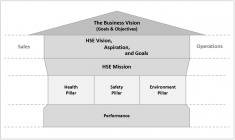

From my first article—“What is Health, Safety and Environment (HSE)?”—to more recent ones about HSE Types and their varying “LESE” priorities, I’ve sought to differentiate effective from defective organisational HSE. Understanding the business and right-sizing HSE to operations and risk is essential for HSE to be fit-for-purpose in protecting enterprise, people and environment.
The culmination of this extended series, then, is the development of the HSE strategy itself, and some of the requisite steps necessary to achieve success.
What is a Strategy?
A strategy is a plan, of which there are good and bad ones. A business strategy can come in many forms, but building one that’s robust first requires an understanding of a strategy’s components and how these fit together. This “extra” time spent can save a lot of wasted effort and resources later on. But first…
Know the Business
Building an HSE strategy is easy. Building one that drives effective HSE and aligns with the priorities of any profit-making business is more challenging. Here’s my approach:
The Business Vision

What is the business’ vision—the common principle that all departmental visions must support. If it’s “to be the best” this implies space to build a world-class HSE department. If it’s to “grow, grow, grow”, then sales and production will be the priority.
The next question is How and where does HSE fit? In either of the above examples, HSE’s role is to communicate the risks to enterprise, people, and environment, and to right-size itself accordingly.
Whatever its business vision, the organisation will have a strategy to achieve it. Specific aspects of this might not be shared by top management—for example, acquisition or divestment plans. Knowing the business’ general direction and its primary objective should be sufficient.
The Business’ Primary Objective
One objective almost certain to be clearly stated is the business’ revenue and profit targets, because all parts of the business will be expected by management to “do their part”.
A specific example might be EBITDA growth of 8% and profit growth of 12%. Knowing this is key to the HSE strategy. Why? Because unless there are economies of scale at play, disproportionate profit-to-growth suggests a cost cutting strategy.
H | S | E can help in its own way by minimising related costs and liabilities; this is how the department might “sell” itself within the business whilst achieving its other LESE drivers. It should also assess existing marginal programmes and tweak or cull these as necessary to increase credibility.
Then Build the HSE Strategy

Once the business context is known, each department can develop its strategy. I adopt a top-down approach where each step builds on the former. It’s critical at key stages of the strategy to seek input from the business—I also find it useful to represent the strategy as a “house” (shown here) to help people understand the process.
As with the roof or pinnacle of any structure, the strategy has its overarching goal—the business vision—which is supported by the organisation’s structural elements (departments), for example: Sales, HSE, and Operations. Each department then develops a strategy which ultimately aims to deliver on the business vision.
Let me expand on this.
HSE’s Vision
This is the HSE Type the organisation chooses for itself, and which very much depends on the business’ vision and priorities. The HSE vision is therefore only a few words long. For instance, if the business vision doesn’t target “being the best”, then proposing “HSE Excellence” or “HSE Leadership” as the HSE vision probably isn’t a good idea.
Defining its HSE Type upfront and having top management sign-off on this gives HSE a clear framework within which it can then produce a coherent, right-sized, and fit-for-purpose strategy.
HSE’s Aspirations
The aspiration is a high-level, succinct statement unique to HSE that outlines what the department hopes to accomplish at some point in time. It is HSE’s qualitative raison d’être—for example, “No injuries, No impacts”.
As the title suggests, this is aspirational and might never be achieved. The aspiration is not the measure of HSE’s success or failure. Because of this, and depending on one’s organisation or approach to strategy building, this section can be excluded if it elicits more questions than answers.
HSE’s Goal
This is the tangible or quantitative, high-level statement unique to HSE and upon which its success or failure will be judged. It is the bridge between the aspiration, above, and the mission, below.
One example might be, “Eliminate all offsite spills, and reduce incidents by 10% year-on-year, by...” This gives the team as a whole, and each H/S/E “pillar” within HSE, its SMART target.
Beware. Many steps might be needed to accomplish the goal and, for HSE, many of those will rely on other parts of the business. Their failure to fully support HSE could be regarded as the latter’s failure.
(Review)
Reading back through the above sections, it should be clear in the HSE strategy how its goal will deliver on the aspiration and this, in turn, on both HSE’ and the business’ visions. If this is not the case, then reassess the strategy.
HSE’s Mission
The “meat” of any plan, and sometimes mistaken for the strategy. The mission is a high-level task list outlining the department’s general day-to-day focus and scope. It will reflect HSE’s core tasks, and infer what measures, indicators, and projects or programmes are needed to achieve success (but it won’t include this detail).
My approach to building the mission is a PDCA one (plan, do, check, act)—also useful for project and change management.
The Four HSE Pillars’ Plans
These are the Health, Safety, Environment, and—the “Silent P”—Performance occupations. Once HSE and the business are aligned with the department’s shared mission, each pillar—including the Performance “foundation”—develops its own occupation-specific strategy that supports the primary HSE mission, goal, aspiration and vision.
Why So Much Complexity?
Firstly, HSE implementation should be straightforward or it risks failing. Secondly, it’s best to get the strategy right the first time. Both of these are made more likely in the planning—the strategy development—phase.
Small-to-medium enterprises will doubtlessly compress the process, but they should still follow the above steps to develop a robust, right-sized strategy. Cutting corners in larger or more complex operations is a recipe for failure.
Whatever the organisation size or complexity, defective HSE Types will inevitably see the above as a waste of time and effort—yet another reason HSE will fail. As for differentiated HSE, read on…
Other Considerations
While the above steps should lead to a robust plan, there are other considerations one should be cognisant of.

What Size Strategy?
Strategies seek to advance the business, raising the question, what magnitude “jump” is being targeted? Is it an A-to-Z version, or an all-in-one AZ plan?
The choice determines the strategy’s lifespan—the “T” in SMART. Too short, and deliverables demonstrating success might not yet be realised. Too long, and progress can stall or non-HSE colleagues might struggle to understand their role.
The right timeframe will allow HSE to assess progress, detect early if the business is off-track, and to course-correct in time.
When to Revise a Strategy?
Assuming the key goal(s) have been met, the answer is now. However, it’s best to periodically revisit the plan to align with it and to ensure it remains valid. When revising the strategy one should review performance, and business challenges and evolution.
In the case of failure—and despite HSE’s efforts—more challenging discussions with management are needed, including whether the organisation’s HSE priorities have changed, and thus its HSE Type.
Targeting Differentiated HSE?
For companies targeting HSE Excellence or HSE Leadership, the bad news is that I believe you need to develop two HSE strategies.
Two strategies! Why?
The first plan will target Integrated HSE and cover day-to-day operational considerations. It may well include best-in-class efforts to achieve this, but the LESE foci will be operational, legal, and financial.
The higher-level plan will focus on reputational, ethical, and social LESE issues; the two strategies will likely have different speeds, timeframes, operational levels, cost centres, and stakeholders.
Separating these out, I believe, increases the likelihood of success.
Roll-out
Once the strategy has been signed-off it requires effective roll-out. Ideally it will have the full support of and be announced by top management, increasing the organisational interest and odds of success.
Closing Remarks
The success of failure of the HSE strategy will determine how effectively enterprise, people and environment are protected.
The development of a robust plan requires an incremental approach with organisational input—especially top management. Whatever the size of the business or HSE strategy, there are advantages to following this process, including getting it right the first time and effective implementation.
Three aspects are critical: understanding the business, knowing its primary objective, and defining and committing to a specific HSE Type—the HSE vision. The rest will build on from this.
What do you think?
Photo credit: fotostorm; Nikada; Jirsak via istock.com.
© Nick Hart (2017) All rights reserved. #hsetypes